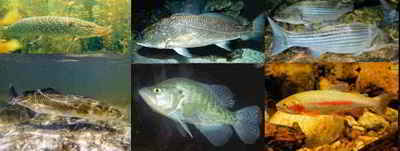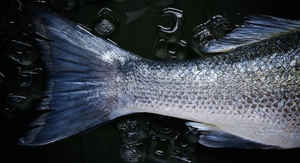Wisconsin State Fish
Muskellunge

(Esox masquinongy masquinongy Mitchell)
Adopted on March 30, 1955.
The musky, (Esox masquinongy masquinongy Mitchell,) was recommended as the state fish because of the dominance of Wisconsin muskies in competition over the years. The trout was also suggested but failed to pass because it wasn't nearly as popular as the musky.
The legislative session of 1939 included spirited debate whether we should have a state fish. A joint resolution recommended the muskellunge (Esox masquinongy masquinongy), but the proposal died in the assembly. A 1941 proposal reached floor debate, but died before reaching the other house. The push for a state fish lay at the bottom of the legislative barrel for another 14 years. In 1955, the muskie was proclaimed the state fish without one vote against it. Go figure! The dedication ceremony was held at the June 1955 National Muskie Festival in Hayward.
Wisconsin State Fish: Muskellunge

"Muskellunge are the largest member of the pike family " Esocidae (Waszcuk, 1996), they resemble the northern pike in most respects, but are distinct in the following respects. The sides vary from greenish to brownish to silverish, usually with dark markings, but the marks may be absent. The white or cream-colored belly often has brownish or grayish spots. The dorsal and anal fins, which are set far back on the body, vary from greenish to brownish to blood red and usually have dark markings. The duckbill-shaped jaws have long, sharp teeth: the roof of the mouth has pads of shorter, recurved teeth. The cheek and gill cover have scales on the top half only. The underside of the jaw has sensory pores, numbers varying from 12 to 20, but the count is usually 15-18. (Sternberg, 1992)
Characteristics of the Muskellunge
Common Name
Better known as the Musky.
Scientific name
Esox masquinongy (Esox comes from the old name for pike in Europe and masquinongy comes from the Cree "mashk" meaning deformed and "kinonge" is a pike.
Food
Muskellunge are the top predator in any body of water where they occur, and they will eat larger prey than most other freshwater fish. Adult muskellunge will eat fish from one-fourth to one-half of their own length and up to 20% of their own weight. Young muskellunge do not hesitate to attack other fish of nearly their own size, grabbing the prey by the head and swimming around with the tail sticking out of their mouth until they digest enough to swallow the rest of the unfortunate victim. Muskellunge fry (the young) start to feed on plankton shortly after hatching. As the fry reach about one inch in length, they begin to feed on tiny insects and at about 2 inches their diet consists mainly of small fish, even including their own kind. Muskellunge feed primarily on fish, insects, ducklings, frogs, muskrats, and mice. There have even been reports of large muskellunge attacking small dogs and even humans, although most of these reports are greatly exaggerated.
Muskellunge feed very little until the spring when the water warms to 50 F. Feeding peaks when the water reaches temperatures of about 70 F, and some feeding continues until the water reaches 80 F. Muskellunge consume more food as the water cools in the fall, but they seldom feed once the water temperature drops below 40 F. (Sternberg, 1992)
Distribution
The muskellunge occurs in all three drainage basins in Wisconsin (Lake Michigan, Mississippi River, and Lake Superior) but is most widely distributed in the Chippewa, Flambeau, St. Croix, Black, and Wisconsin rivers of the Mississippi basin. Its presence in central and southern Wisconsin is the result of widespread stocking of fry and fingerlings.
Muskellunge inhabit freshwater rivers and lakes and can survive in a wide range of water temperatures. Muskellunge prefer water in the 67-to 72-degree range and are hardly ever found in waters with a maximun temperature below 68 F.
Muskellunge favor clear water and cannot adapt to water that stays turbid most of the time. They also have a well-defined home range. Several studies have shown that muskellunge seldom leave their home range, except to spawn, although they roam about within it. The larger the body of water the larger the home range. Although they prefer shallow, weedy water (less than 20 feet deep) during their early years of life, as they grow larger, they spend more time in deep water.
Muskellunge cannot endure fast current, so they are seldom found in rivers with high gradient (drop), of more than 10 feet per mile. If there are backwater areas where they can get out of the moving water then they will live in rivers with higher gradients and faster currents. (Sternberg, 1992)
Spawning
Within the north and south limits of the Wisconsin muskellunge range, spawning occurs from mid-April to mid-May, with the peak occurring early in the season. Optimum spawning temperature is about 55° F, but may range from 49 to 60° F. Eggs are usually deposited indiscriminately over several hundred yards of shoreline. There is no parental care. Adult spawners return to the same spawning ground in consecutive years.
Wisconsin Law
The law designating the muskellunge as the official Wisconsin state fish is Section 1.10(3)(g) of the Wisconsin Statutes, Chapter 1 (SOVEREIGNTY AND JURISDICTION OF THE STATE) Section 1.10 (State song, state ballad, state waltz, state dance, and state symbols)
CHAPTER 1 SOVEREIGNTY AND JURISDICTION OF THE STATE
1.10 State song, state ballad, state waltz, state dance, and state symbols.
1.10(3)(g)
(g) The muskellunge (Esox masquinongy masquinongy Mitchell) is the state fish.
Taxonomic Hierarchy: Muskellunge
Kingdom: Animalia - animals
Phylum: Chordata - chordates
Class: Actinopterygii
Order: Esociformes
Family: Esocidae
Genus: Esox
Species: Esox masquinongy








